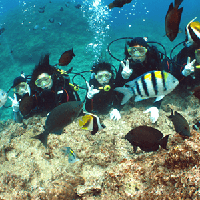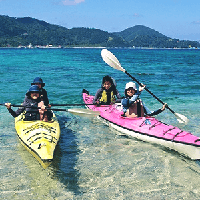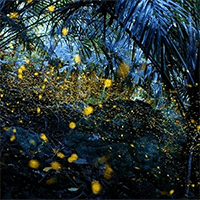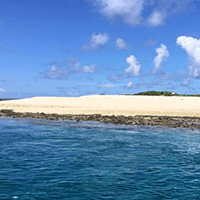Awaji Island in Handmade / Handcraft workshops
- Age 0~Age 100
- Within 1 hour /1~2 hours
- 10:00 / 11:00 / 12:00 / 13:00 / 14:00 / 15:00 / 16:00 / 17:00
Create your own one-of-a-kind original bear! Figures start at 23cm, and we offer a variety of cute figures, including bears and rabbits. The workshop is expected to take between 45 minutes and an hour and a half. You can also use any leftover paint to paint a tote bag (an additional ¥1,000). If you visit Awaji Island, making your own bear at MYBEAR STUDIO Awajishima is a must-try. This art experience, reminiscent of a coloring book, is sure to captivate everyone, from small children to adults. First, choose your favorite bear or figure, then paint it freely with plenty of colorful paint. The charm of this studio is that you can have fun to your heart's content, without worrying about getting your hands dirty. Keychains take one hour, while larger bears take about two hours. Once completed, you can choose the option to add a glossy coating and have it delivered by mail (an additional ¥1,000 shipping fee). You can also use any leftover paint to paint a tote bag (¥1,000), or try your hand at making accessories with a selection of over 30 types of bracelets and necklaces, and over 300 charms! You can ask a staff member for help, or make it yourself. You'll create a one-of-a-kind treasure. The facility is barrier-free and includes a kids' space. Pets are welcome, so the whole family can enjoy themselves with peace of mind. It's perfect for rainy days or a little downtime, and it's also a popular photo spot. The entrance has a ramp, making it easy to enter with a stroller or wheelchair. It tends to get crowded on weekends and holidays, so we strongly recommend making a reservation in advance. Please feel free to contact us with any questions! [Price] Per person (Bear Art Keychain Size: From 3,000 yen) (Bear Art Figure Size: From 8,500 yen) (Original Accessory Making: From 3,000 yen) *The minimum price for the bear art experience is 3,000 yen for the keychain and 8,500 yen for the original bear. Prices vary depending on the figure and options, so please check on-site. Optional gloss and matte finishes are available for an additional 500 to 1,000 yen. Delivery takes approximately one to two weeks after completion. A separate shipping fee of 1,000 yen is required. For both keychain and figurine creation, please book the Bear Art Experience Plan. *The minimum fee for making original accessories is 3,000 yen. The price varies depending on the type and number of bracelets, necklaces, and charms, so please check on-site. Example: Bracelet 3,000 yen x 1 piece Charms 300 yen x 4 pieces Total 4,200 yen
お盆とあって、たくさんのお客様がいる中、丁寧に対応していただきました。子供たちに優しくアドバイスもしてくださり、すごく楽しい時間を過ごすことができましたっ!! ありがとうございました! また利用したいと思います♪
- Age 6~Age 100
- 3~4 hours
- 09:00 / 14:00
"Ko-Iga" is the highest peak of pottery in history, known as "exceptional beauty" in the world of tea ceremony, mainly during the Sengoku period, when Sen no Rikyu, Oda Nobunaga, and Toyotomi Hideyoshi were active, and the Azuchi-Momoyama period. Experience Awaji Iga making, a reproduction of the Ko-Iga making used in tea ceremony at that time, with one-on-one guidance from a craftsman who hand-made the largest six-tiered climbing kiln in Japan. Ko-Iga is fired at the world's highest firing temperature of 1400℃ for several days, which is unparalleled in the world, so the shape is distorted and sometimes it breaks when firewood is repeatedly hit against it, but the absolute presence and scenery that surpasses this are known as exceptional beauty. (*250℃-450℃ in a bonfire, 1500℃ in a blast furnace) Awaji Iga aims to revive Ko-Iga and values the invisible process and value, so it does not use modern tools such as burners and thermometers, or glazes that glassify the surface. During the Sengoku period, wars were taking place all over Japan, but no one really wanted war, and tea ceremonies served as a place for secret talks to avoid war. It is said that Ko-Iga was used as a special tool to hold a special tea ceremony, which could avoid war if successful, or lead to war if unsuccessful. At Tsurugi Kiln, you can experience the revival of Ko-Iga, which was used in tea ceremonies that determined history and people's lives and deaths, and the making of Awaji Iga pottery. *The actual experience is limited to the forming process. During the four days and nights of the kiln firing in February, you can visit the impressive site at any time. Please visit Awaji Island three times to enjoy the forming process, the kiln firing in February, and the collection after April. ■Itinerary 1. Decide what to make 2. Knead the clay 3. Shape, make strings, hand-form, and make balls *The actual experience is limited to the forming process. During the kiln firing in February, you can see the items you made yourself. *As the items are fired once a year during the kiln firing in February, they will be handed over after spring.
- Age 10~Age 100
- 1~2 hours
- 09:00 / 10:00 / 13:00 / 14:00
You can enjoy playing with natural materials in the gallery with an ocean view in the tile factory in Awajishima! Adults and children an extraordinary experience with an "immersive experience" ♪
- Age 10~Age 100
- 1~2 hours
- 09:00 / 10:00 / 13:00 / 14:00
You can enjoy playing with natural materials in the gallery with an ocean view in the tile factory in Awajishima! Adults and children an extraordinary experience with an "immersive experience" ♪
- Age 6~Age 100
- 2~3 hours
- 09:00 / 10:00 / 11:00 / 13:00 / 14:00
Daisuke Michigami, a roofer who has inherited the family business (president of Daiei Ceramics), continues to take on the "indefatigable challenge" of unraveling the "wisdom," "skills," and "teachings" of his predecessors that are embedded in each and every "Awaji tile," a traditional industry that has a history of 400 years, and passing them on to the future. What is the reason for continuing to take on new challenges? We will get to the bottom of the secret. Daisuke Michigami, a roofer, will talk about the charm of "tiles" created by the soil of Awaji over time, the thoughts he puts into making each and every tile, the scenery created by the layers of "tiles," and his commitment to the "beauty" of Japanese architecture, all at "Gallery Doza," a space completely wrapped in soil and tiles. Awaji tiles were hit hard by the unfounded rumor that "the damage caused by the Great Hanshin-Awaji Earthquake was so great because the roofs were tiled." Even in an environment where the survival of Awaji tiles is still in doubt, Michigami has found great potential in "Ginfurubi" (tiles that are new yet somehow nostalgic, baked to a vintage, antique texture), and has been bringing out new charms of Awaji tiles that are different from anything that has come before. Now that his thoughts have taken shape, tiles are connecting people with each other, and Japan's good old traditional beauty is being reevaluated. Tile maker Michigami Daisuke's "insatiable challenge" will continue. After listening to his story, you can enjoy a space surrounded by earth and tiles that you would never believe is inside a tile factory, a view of the townscape that has flourished due to tile production since the Edo period, and Michigami's passion for "beauty" at "Gallery Doza," where you can feel Michigami's passion for "beauty." You can pretend to be a tile craftsman and try making your own "one-of-a-kind tile coaster," one of the new possibilities of tiles. You can choose from a variety of Japanese pattern designs that are prepared in advance, as well as original designs. Try making a rich work full of your sensibility. Experience schedule9:00~ (20 minutes) Message from tile maker Daisuke Michigami (President of Daiei Ceramics Co., Ltd.) - "Creating the future of tiles" - He will talk while showing slides at [Gallery Doza].9:20~11:20 Experience making your own original tile coaster that is one of a kind in the world *You can start at any time between 9:00 and 14:00.
- Age 5~Age 100
- Within 1 hour
- 11:00
Approximately 70% of domestic incense sticks are manufactured on Awaji Island. Among them, the Ei district is where many manufacturers gather, and you can smell the delicious aroma of incense as you walk through the town. It has even been selected as one of the "100 Scented Landscapes" by the Ministry of the Environment. This is a valuable experience where you can visit an incense manufacturer that has been manufacturing incense since 1905 and still maintains traditional handmade manufacturing methods, learn about the history of Awaji Island incense sticks, knowledge of fragrance, and the manufacturing process from a fragrance master called a "Koshi", and experience part of the manufacturing process while receiving a lecture from a veteran craftsman. After learning the basics of incense from a fragrance master called a "Koshi" at an incense manufacturer on Awaji Island, which accounts for approximately 70% of the domestic incense market, you will receive a lecture from a veteran craftsman and experience part of the actual manufacturing process. It is a valuable opportunity to listen to the craftsman's story! *The experience will involve cutting the sticks into bonkiri (a bonkiri stick) and putting them raw on the sticks.
- Age 5~Age 100
- 1~2 hours
- 11:00
Approximately 70% of domestic incense sticks are produced on Awaji Island. Among them, the Ei district is where many manufacturers gather, and you can smell the delicious aroma of incense as you walk through the town. It has even been selected as one of the "100 Scented Landscapes" by the Ministry of the Environment. Visit an incense manufacturer that has been producing incense since 1905 and continues to produce it by hand, learning about the history of Awaji Island incense sticks, knowledge of fragrance, and the manufacturing process from a fragrance master called a "Koshi", and experiencing making your own original incense. After learning the basics of incense by visiting a manufacturer of incense sticks on Awaji Island, which accounts for approximately 70% of domestic incense sticks, and learning about the history and knowledge of fragrance of Awaji Island incense sticks, as well as the traditional manufacturing process, it's time to make your own incense! Choose the color of the incense, put the ingredients and water in a mortar and knead. Blend your favorite fragrances and knead again, then use a die to shape the incense. Take it home and let it dry thoroughly for about a week, and your incense is ready! You can experience making your own scent at home. [Experience Schedule] 11:00 Meeting Observe the traditional incense manufacturing process at Awaji Umekundo Ei Factory (30 minutes) 11:30 Learn about the history of incense and fragrance knowledge from a Kohshi (producer) and experience making incense (80 minutes) 12:50 Scheduled to end
- Age 5~Age 100
- 1~2 hours
- 11:00
Approximately 70% of domestic incense sticks are produced on Awaji Island. Among them, the Ei district is where many manufacturers gather, and you can smell the delicious aroma of incense as you walk through the town. It has even been selected as one of the "100 Scented Landscapes" by the Ministry of the Environment. Visit an incense manufacturer that has been producing incense since 1905 and continues to produce it the traditional way, learning about the history of Awaji Island incense sticks, knowledge of fragrance, and the manufacturing process from a fragrance master called a "Koshi", and experiencing making your own original sachet. After learning the basics of incense by visiting an incense manufacturer on Awaji Island, which accounts for approximately 70% of the domestic incense market, and learning about the history of Awaji Island incense stick production, knowledge of fragrance, and the traditional manufacturing process, you can finally experience making an incense sachet. You can mix your favorite fragrance ingredients and make an original sachet to put in your favorite sachet, and enjoy the scent at home. [Experience Schedule] 11:00 Meeting point Observe the traditional incense manufacturing process at Awaji Baikondo Ei Factory 11:30 Learn about the history and scents of incense from a Kohshi (producer) and experience making a scented sachet (50 minutes) 12:20 Scheduled end
- Age 7~Age 75
- 1~2 hours
- 10:00
This is an experience tour where you can learn about Japan's fragrance culture and create your own original fragrance together with a master incense maker. Awajishima is the number one incense producing area in Japan. Take a stroll through Eiura, a town where incense production began around 1850, and visit an incense stick workshop where traditional handicrafts are still used. Together with a master incense maker, you will mix your own original fragrance using natural incense ingredients used in high-quality incense sticks. You will also create your own sachet and incense.
- Age 13~Age 100
- 3~4 hours
- 10:00
With a history of 1400 years, tiles have protected Japanese houses, including shrines and temples. Among them, there are "Onishi" who have the skills of a master craftsman who draws a blueprint in his head while looking at the drawing with his own eyes without using blueprints or molds, and finishes it only with the sense of his fingertips and a handmade spatula. You can make a one-of-a-kind oni tile by learning from an "Onishi" how to make oni tile by hand using "name-do" soil that is more than 2 million years old. Awaji Island is one of the three major production areas of tiles in Japan, and is the number one producer of smoked tiles that shine with "silver". Tiles have a history of more than 1400 years, and tile making has been going on in Awaji Island for more than 400 years. Moreover, the soil used for Awaji tiles is still more than 2 million years old, and the very fine particles of "name-do" are used to create smoked tiles that shine with a beautiful silver color by baking (smoking) them in a kiln. In Japan, onigawara tiles have been used to decorate roofs as a talisman since ancient times. Even today, these onigawara tiles are carefully handcrafted by oni-shi (demon craftsmen) without the use of machines. Normally, you don't get to see onigawara tiles being made, but in this experience, you can watch the onigawara craftsmen's skills up close and make onigawara tiles together. Since this experience is limited to one group, you can make onigawara tiles without worrying about other people. If you have any questions or questions about how to make them, you can ask the onigawara maker at any time, and it is an experience where you can experience traditional techniques in a private atmosphere. [Procedure] 1. Draw a rough sketch of the image (you can also bring a draft with you) 2. Decide on the design of the onigawara tile 3. Together with the onigawara maker, use tile clay (nametsu) to create a rough shape 4. Let it cure (eat lunch (each person) during this time) 5. Finish the fine details using a spatula and your fingertips 6. Completed (you can also take a commemorative photo with the onigawara maker) *The work will then be carefully dried and fired and delivered in about two months. *For lunch, you can enjoy Awaji Island's specialty "Kawara-yaki" at the facility (additional charge required).
最近チェックしたプラン
Please wait a moment
![Make memories on Awaji Island! Experience one-of-a-kind bear art and accessories! [★Families, couples, and pets welcome★]の画像](https://img.activityjapan.com/10/59269/10000005926901_JPXg7sWy_3.jpg?version=1754256122)
![[Hyogo, Minami Awaji] Experience making "Awaji Iga", a reproduction of "Ko-Iga", the highest peak of pottery in history, which was known as "exceptional beauty" in the world of tea ceremony mainly during the Sengoku period!の画像](https://img.activityjapan.com/10/58639/10000005863901_1Gz5AIDf_3.webp?version=1744257065)
![[Hyogo/ Awajishima] The theme of Awajishima's nature ♪ Tile coaster making experience that anyone can easily doの画像](https://img.activityjapan.com/10/49898/10000004989801_atFOJjl6_3.jpg?version=1690422903)
![[Hyogo/Awajishima] Challenge the craftsmanship! Authentic tile coaster experienceの画像](https://img.activityjapan.com/10/49897/10000004989701_atFOJjl6_3.jpg?version=1690421703)
![[Hyogo, Minami Awaji] Awaji tiles, a traditional industry with 400 years of history. A tile maker who continues to challenge himself to create the beauty of Japanese architecture. A coaster-making experience.の画像](https://img.activityjapan.com/10/58552/10000005855201_1Gz5AIDf_3.webp?version=1743738427)
![[Awaji, Hyogo] Learn from active craftsmen of a manufacturer that preserves traditional handmade manufacturing, and experience some of the processes involved in making incense, a traditional industry on Awaji Island, in a town of incense that has continued since the Edo period.の画像](https://img.activityjapan.com/10/58861/10000005886101_nXyAW2Zv_3.webp?version=1745205481)
![[Awaji, Hyogo] Learn about the history and basics of fragrance from a fragrance master in this town of incense that has been around since the Edo period, and create your own original incense by choosing the scent and shape.の画像](https://img.activityjapan.com/10/58859/10000005885901_nXyAW2Zv_3.png?version=1745203267)
![[Hyogo/Awaji] Learn all about fragrances and then make your favorite scented sachet at an incense manufacturer that preserves traditional handmade manufacturing.の画像](https://img.activityjapan.com/10/58819/10000005881901_nXyAW2Zv_3.png?version=1744872913)
![[Hyogo, Awajishima] Learn from the masters of incense making and experience creating Japanese fragrancesの画像](https://img.activityjapan.com/10/57644/10000005764401_shBc59Sl_3.jpg?version=1738553603)
![[Hyogo, Minami Awaji] Try your hand at making onigawara tiles, a tradition that has continued for over 400 years! Learn from a master craftsman, the oni-shiの画像](https://img.activityjapan.com/10/58778/10000005877801_1Gz5AIDf_3.webp?version=1744699742)







